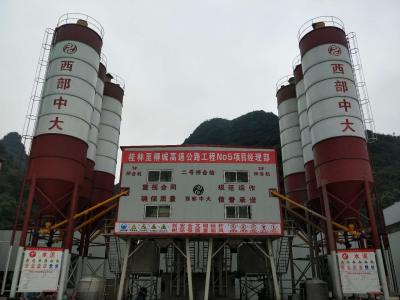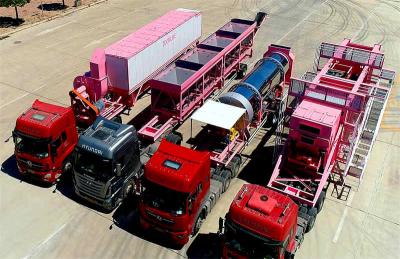Stationary and Mobile Concrete Mixing Plant
Generally speaking, concrete mixing plant is divided into two categories: fixed mixing plant and mobile mixing plant, which is also the first classification that many manufacturers distinguish in production. Most of the fixed mixing plant adopts modular and easy-to-put-together design, which is mainly used in large-scale commercial concrete manufacturers, or concrete component manufacturers, and can be used in large-scale construction projects, featuring strong production capacity, stable work and good anti-interference. The mobile mixing plant is towed by a trailer unit, good mobility, so that the production is more flexible, generally used for a variety of small and medium-sized temporary construction projects, rental and self-use can be.
According to the purpose, concrete batching plant can be divided into commercial concrete mixing plant and engineering concrete mixing plant, commercial mixing plant is a concrete mixing plant mainly for commercial purpose, which should have high efficiency and economy, and at the same time meet the requirements of environmental protection, and the engineering mixing plant is for self-use, so it should be considered whether it is compatible with its own project.
According to the layout process, generally divided into one-stage and two-stage, one-stage refers to a one-time sand and gravel aggregates, cement, etc., lifted to the top of the mixing plant silo, a variety of materials in accordance with the production process from top to bottom, and ultimately from the bottom of the discharge, mostly in the mixing building. This kind of mixing plant is divided into silo layer, weighing layer, mixing layer and discharging layer from top to bottom, with very high mixing efficiency, but it is difficult to build, inconvenient to demolish and relocate, and high investment cost, while the second-order relative to the first-order, the aggregate will be weighed and lifted up the mixer again, although it occupies a large area, and the mixing efficiency is a little lower than that of the first-order type, but it is convenient to dismantle and assemble, with low manufacturing cost, easy to install, and it is widely used. However, it is easy to dismantle, low manufacturing cost, easy to install, and widely used, and the improved production capacity of the second-order mixing plant can be comparable to the first-order type.
According to the number of mixers, the mixing plant can be divided into single-host station and double-host mixing plant, the model name of the double-host mixing plant is 2HZS series concrete mixing plant, such as 2HZS25 concrete mixing plant to express the meaning of the double-host mixing plant with 2 sets of JS500 mixing hosts with a theoretical production rate of 2 * 25m³/h, the double-host mixing plant is the same type of mixing plant, a very good supplement!
According to the weighing method, it can be divided into independent weighing and cumulative weighing, separate weighing will be equipped with a separate weighing unit for each material, and after each material is weighed, it will be added to the mixer for internal mixing, which is a high precision weighing method, but the design is complicated and the cost is high; the cumulative weighing is to add all aggregates into a unified hopper, which is easy to produce an accumulation of errors, which is unfavourable to the final production, and the more the number of batching silos is, the more prone to deviation, and the higher the number of batching silos is, the more prone to deviation. The more the number of batching bins, the more likely to have deviation, not suitable for large-scale projects. However, the structure design is simple and the cost is cheap.



